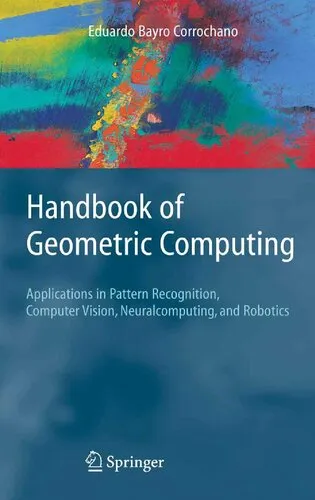Handbook of Geometric Computing: Applications in Pattern Recognition, Computer Vision, Neuralcomputing, and Robotics
4.0
Reviews from our users

You Can Ask your questions from this book's AI after Login
Each download or ask from book AI costs 2 points. To earn more free points, please visit the Points Guide Page and complete some valuable actions.Introduction to "Handbook of Geometric Computing: Applications in Pattern Recognition, Computer Vision, Neuralcomputing, and Robotics"
The study of computational geometry and its applications has grown exponentially in recent years, especially with the advent of artificial intelligence, machine learning, and robotic systems. The "Handbook of Geometric Computing: Applications in Pattern Recognition, Computer Vision, Neuralcomputing, and Robotics" provides a comprehensive look at the essential applications and theoretical frameworks associated with geometric computing. Written with interdisciplinary rigor, this book bridges mathematics, computer science, and engineering principles to offer readers a detailed roadmap of how geometric algebra and computational methods are applied in solving real-world problems.
Whether you are a student, researcher, or practitioner in fields like computer vision, robotics, or pattern recognition, this book provides the foundational tools to understand and implement geometric computing techniques effectively. By exploring various mathematical constructs like homographies, conformal models, and quaternion algebra, the text enables professionals to better model, analyze, and solve complex computational problems. It unravels new ways of thinking about how machines perceive and interact with their surroundings, powered by a more structured and systematic approach to geometry and algebra.
Detailed Summary
The book is divided into multiple chapters, each delving deep into a facet of geometric computing:
It begins with a strong foundational introduction to geometric algebra and its computational advantages. Traditional methods in pattern recognition, robotics, and image processing often neglect the elegance and robustness provided by these algebraic tools. Through clear examples and vivid illustrations, the book explains how these models unify various representations of geometry, offering a universal language to tackle diverse problems.
In the sections on pattern recognition, the book highlights the use of geometric methods to analyze and classify patterns. It demonstrates how these techniques enhance feature extraction, dimensionality reduction, and decision-making processes. Likewise, in computer vision, the text introduces sophisticated transformations and projections that allow computers to perceive 3D spaces more intuitively from 2D inputs.
The neuralcomputing section integrates cognitive sciences with computation, presenting models that simulate neural learning processes using geometric frameworks. Complex neural networks, often seen as abstract and high dimensional, are simplified through geometric representations, ensuring clarity and improving computational efficiency.
Lastly, in robotics, the fundamental chapters present practical approaches for motion planning, navigation, and sensor fusion, all underpinned by geometric algebra. Robots equipped with these paradigms are not just highly functional but also adaptable to changing and dynamic environments, ensuring optimal performance.
Key Takeaways
- Geometric algebra provides a unified language for multiple domains in computing, from simple spatial reasoning to complex 3D transformations.
- The book bridges the gap between mathematical abstraction and practical applications, making it ideal for interdisciplinary research and developments.
- Readers learn novel methods for improving the efficiency and accuracy of common tasks like pattern recognition and robotics navigation.
- Contains numerous examples and exercises, enabling readers to apply theoretical models directly to computational problems.
- Presents emerging concepts like sensor fusion and neural-geometric computing, offering insights into frontier research areas.
Famous Quotes from the Book
"By embedding geometry within algebra, we transcend the limitations of classical computing, enabling intelligent machines to bridge dimensions as seamlessly as humans envision them."
"Geometric computing is not just a toolkit—it’s a paradigm that redefines how we approach and solve problems in the computational world."
"To understand the world geometrically is to see the underlying structure behind forms, patterns, and motions; to compute it is to make sense of this structure and use it effectively."
Why This Book Matters
Geometric computing stands at the crossroads of powerful modern technologies such as AI, robotics, and data analysis. Despite its clear potential, many practitioners and researchers struggle to adopt its principles due to the perceived mathematical complexity. This book eliminates that barrier by presenting solid theoretical foundations in an accessible format, combined with practical paradigms for real-world applications.
With a focus on interdisciplinary application, the book allows engineers, mathematicians, and computer scientists to collaborate more effectively. By standardizing geometric and algebraic tools across domains, it opens the door to new possibilities—autonomous machines that learn better, systems that see in 3D with minimal errors, and algorithms that classify patterns with unparalleled accuracy.
Ultimately, this book is a foundational text for anyone who wants to push the boundaries of spatial computing. It not only educates but also inspires its readers to think differently, question existing paradigms, and embrace new horizons in geometric technology.
Free Direct Download
You Can Download this book after Login
Accessing books through legal platforms and public libraries not only supports the rights of authors and publishers but also contributes to the sustainability of reading culture. Before downloading, please take a moment to consider these options.
Find this book on other platforms:
WorldCat helps you find books in libraries worldwide.
See ratings, reviews, and discussions on Goodreads.
Find and buy rare or used books on AbeBooks.
1189
بازدید4.0
امتیاز50
نظر98%
رضایتReviews:
4.0
Based on 0 users review
"کیفیت چاپ عالی بود، خیلی راضیام"
Questions & Answers
Ask questions about this book or help others by answering
No questions yet. Be the first to ask!


